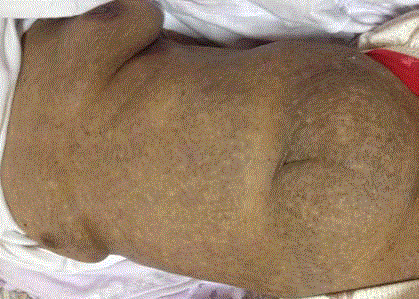Editorial
Breast Cancer Revealed by Paraneoplastic Pemphigus
Naqos N*
Department of Medical Oncology, Mohammed VI University Hospital, Morocco
*Corresponding author: Naqos N, Department of Medical Oncology, Mohammed VI University Hospital, Morocco
Published: 08 May, 2017
Cite this article as: Naqos N. Breast Cancer Revealed by
Paraneoplastic Pemphigus. Clin Oncol.
2017; 2: 1282.
Editorial
Paraneoplastic pemphigus is an autoimmune disorder stemming from an underlying tumor.
It is hypothesized that antigens associated with the tumor trigger an immune response resulting
in blistering of the skin and mucous membranes. We report a case of 42 years old woman with no
medical history who presented in 2010 a generalized bullous eruption; bubbles were of variable
size with clear content, they were associated with erythematous skin. They were flabby, easily
broken. Healing sometimes was slow and leaved persistent pigmented macules. Skin involvement
was polymorphic: it took the appearance of bullous lesions, of polymorph erythema or of bullous
pemphigoid. Biopsy showed an histological picture that involves a supra basal cleavage, keratinocyte
necrosis and a lichenoid infiltrate of the dermis, and production of antibodies against the Dsg1
the Dsg3 and some proteins of the family of plakines (desmoplakin I and II envoplakine). The
histological and the polymorphic skin involvement were attributable to a Paraneoplastic pemphigus.
Clinical examination found a right axillary lymphadenopathy without any evident breast nodule,
the adenectomy objectived an invasive ductal carcinoma SBR III with hormonal receptors positive
and Her2 neu positive (score 3) (Figure 1). The patient was lost of view during 1 year, she presented
in 2011 with the same exacerbated skin lesions and clinical examination found a palpable mass in
the upper extern quadrant of the left breast; biopsy showed an invasive ductal carcinoma; CT scan
objectived pulmonary and liver metastasis.
Combined chemotherapy was prescribed: 5-FU 500 mg/m2 iv d1 Epirubicin 100 mg/m2 iv d1 and
Cyclophosphamide (Cytoxan) 500 mg/m2 iv d1 + prednisone. After 6 courses a very good response
was noted; the skin lesions were resolved leaving persistent pigmented macules. We obtained a
remarquable reduction of pulmonary and liver metastasis.
Paraneoplastic pemphigus is an autoimmune bullous disease defined by clinical, histological
and immunological criteria. The prognosis of this disease is particularly severe depending mainly
on the associated neoplasia.
Figure 1
Figure 1
The patient was lost of view during 1 year, she presented in 2011 with the same exacerbated skin
lesions and clinical examination found a palpable mass in the upper extern quadrant of the left breast; biopsy
showed an invasive ductal carcinoma; CT scan objective pulmonary and liver metastasis.

